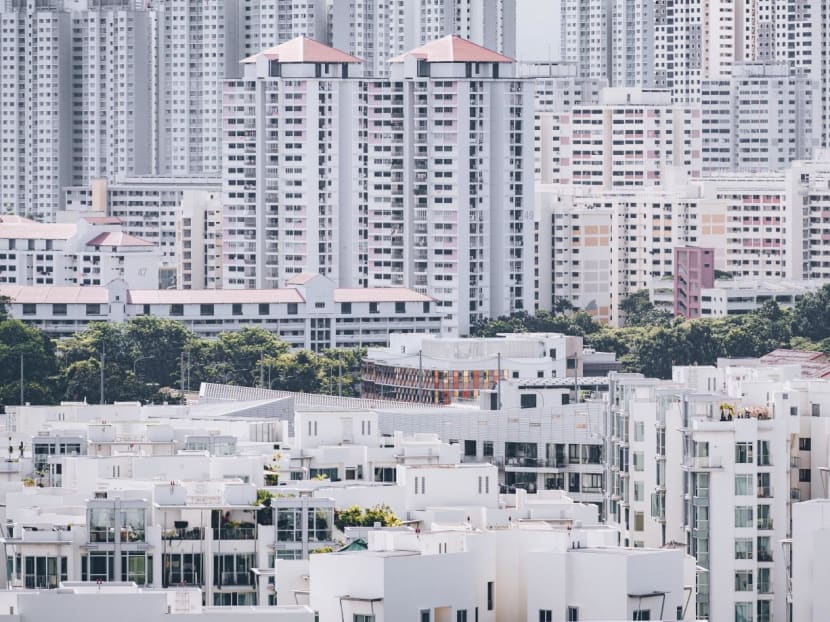An alternative to the norm: What if some housing developments were only built for renting?

- Build-to-rent projects have gained ground in other countries, offering diversity in housing for various needs
- Analysts believe this model could work in Singapore as housing aspirations change
- Concerns include high upfront costs, long payback periods for developers and risk of unpredictable "social ramifications"
SINGAPORE: As property prices climb and people's aspirations change, a housing model in which units are not for sale but only for rent could work in Singapore, analysts said.
Under this build-to-rent (BTR) model, which has gained traction overseas, all units are often managed by a single, institutional landlord.
This is in contrast to the build-to-sell (BTS) model that dominates Singapore’s property landscape, under which units are sold to individual buyers.
The prospect of a BTR model was raised in March this year by Nominated MP Cheng Hsing Yao. Mr Cheng, head of real estate developer GuocoLand, noted then that the BTR model was becoming more prevalent in other cities and was attractive to younger people, families and retirees.
The idea was raised again in November by MP Louis Chua (WP-Sengkang) as part of a broader pitch for more diverse housing options. He urged authorities to increase the stock of public rental housing across all flat sizes, and mooted a public-private BTR collaboration as one way to develop this supply.
WHY WOULD BUILD-TO-RENT MODELS HELP?
Generally, BTR projects differ from service apartments or co-living apartments as they are meant for longer-term stays.
They are also professionally managed, often with handymen service, housekeeping or community engagement programmes, said Mr Cheng in March.
More importantly, these rental units would be useful even in a country with extremely high home ownership rates to cater to changing aspirations and needs, said real estate analysts.
Ms Tang Wei Leng, managing director of Colliers Singapore, said that given Singapore's success with home ownership rates at about 90 per cent, it is timely to “provide an alternative housing option for different users – not just younger Singaporeans, but different age profiles”.
“A lot of things have transformed and evolved over COVID, so much so that one keyword that has come up very often is flexibility. Rent offers a lot more flexibility versus purchase.”
It would also cater to the growing desire for mobility, she said. For instance, those hoping to work overseas may not want to plunge into buying a home and instead prefer to rent.
PANDEMIC, RISING PRICES "MAGNIFIED" NEED FOR MODEL
Mr Alan Cheong, Savills Singapore’s executive director of research and consultancy, echoed that the pandemic has “magnified, accentuated and accelerated” the need for a BTR concept.
Demand for rental units has grown, amid the work-from-home phenomenon which has driven younger workers to crave more space of their own, he said. Their rising incomes have also allowed them to act on this desire.
Lifestyles are also changing, with more people delaying marriage or choosing to remain single, Mr Cheong said. More are also marrying foreigners and may want to buy a home in their spouse's country and rent one in Singapore.
Ms Alice Tan, head of consultancy at Knight Frank Singapore, added that the idea of injecting new home supply with more rental units also comes against a backdrop of rising property prices.
The renting model could also “promote a spirit of entrepreneurship" among those who want to invest in business instead of property. Diverse accommodation choices also make living and doing business in Singapore more attractive, she said.
SENIORS CAN BENEFIT TOO
A BTR model would also support an ageing population as seniors and empty nesters choose to downsize their properties, said Colliers' Ms Tang.
“If you don't like it, there’s (Sellers’ Stamp Duty) to consider and you got to suck it up and live in it for the next few years before you can move. However, if you rent, you can experiment. You can consider: Does it suit you?”
She added that having a single landlord may offer more security and comfort to older folks. One could also meet like-minded people in the development or those from different walks of life, with the chance of building new friendships, she said.
Ms Tang described the BTR model as “a very scalable proposition” in light of the current demand in the market.
“It offers different business possibilities, and it offers developers the potential of stable long-term income, asset management opportunities which could eventually be spun into a real estate investment trust (REIT).”
WILL DEVELOPERS BITE?
Knight Frank’s Ms Tan said there is indeed growing interest in new rental formats, including co-living, as construction delays squeeze home supply.
But while developers are keeping tabs on the trend, she does not see many exploring this as the traditional build-to-sell model is still “generally profitable in Singapore”.
The high upfront costs of land development in Singapore – including land, construction and stamp duties – means that the BTR model may not be viable. The payback period under this model is also much longer, she said.
“The business case of the BTR model must be proven in terms of longevity and sustainability from end-user demand and costs perspectives, before more private developers will undertake this in a big way.”
Savills’ Mr Cheong agreed that not all developers would be keen, with hotel or hospitality companies and private equity firms more likely to show interest.
But NMP Mr Cheng said the model is an asset class sought after by many global institutional investors, and “private global capital is ready to be tapped in this instance”.
PUBLIC-PRIVATE COLLABORATION
While overseas BTR projects are often private ventures, there is scope for private-public collaboration too.
In March, Mr Cheng called on authorities to review some areas to encourage “active and responsible participation by the private sector”, including in land supply, development, and creating an eco-system of developers and service providers.
On what such partnerships could look like, Knight Frank’s Ms Tan suggested a cost-profit sharing model.
Private sector expertise could add value to BTR projects in design creativity and best practices in management. The public sector could pilot some projects by putting government land sale plots up for tender with a BTR requirement, she said.
Workers' Party MP Mr Chua cited a similar example in Queensland, Australia, where authorities are working with private developers on affordable rental housing. They have approved two BTR projects – including one by Singapore-listed developer Frasers Property.
Mr Chua also earlier said that given the resilience of Singapore's residential housing market compared to retail and commercial properties during the pandemic, he was confident there would be “no lack of interest by private developers” to partner with the Housing Board in coming up with such models.
But if HDB does decide to embark on a BTR model, “there would also have to be the associated safeguards and policy changes to take effect alongside it”, he told CNA over email.
"At present, not only are commercial market rentals expensive ... they do not offer much certainty to lessees both in terms of tenure, rent and other form of protections as these are typically for a lease tenure of one to two years and with no certainty on renewal and no certainty on rental rates upon renewal. So this would have to be looked into first."
Colliers’ Ms Tang also said criteria on who is allowed to rent public flats may also have to be refined.
MAINSTREAMING RENTALS REQUIRES "DEEP CONSIDERATION"
Following Mr Chua’s motion in November, Senior Minister of State for National Development Sim Ann said “home ownership has been and will continue to be" the key strategy in Singapore’s public housing policy.
Though authorities will keep studying changing preferences and developing policies to meet these, “mainstream rental represents a significant departure from our public housing policy and principles”, said Ms Sim.
“It will reshape our social norms and could weaken our communities, because unlike home ownership where people sink their roots, rentals are more transitory. This is not something we will embark on lightly, without deep consideration.”
In the meantime, authorities will “continue to prioritise our resources to support Singaporeans in achieving their home ownership aspirations – that is, homes owned by Singaporeans, and not by private investors through REITs.”
DIFFICULT TO PREDICT SOCIAL OUTCOMES
Another issue, noted Savills’ Mr Cheong, is that having such a new housing model may have social impacts that are hard to predict.
“If you have BTR, you may also be encouraging people not to get married, you could keep the camp in that direction. Population size and birth rates may fall.
“That’s where the danger is – it’s hard to think of the ramifications (which) are going to spawn out into the unknown.”
There are also “legacy ideas” to overcome, he said, pointing to deep-rooted cultural ideas linking home ownership and status.
Knight Frank’s Ms Tan also noted that “Asians view home ownership as a long-term investment asset and a symbol of success in one’s life phase”.
Ultimately, Mr Chua pointed out that it does not have to be an “either or” model of home ownership versus rental, and “we should not automatically assume one model is superior compared to the other”.
“For Singaporeans, everyone’s circumstances change all the time, and we should cater to Singaporeans’ housing needs across life stages, as people may decide it is most appropriate to rent or buy at different stages of their lives.”
Colliers’ Ms Tang agreed, saying respect should be accorded to the different reasons and aspirations behind both options.
She added that “there isn’t a need for us to be deliberate" about changing people's attitudes towards the value of renting versus home ownership.
“It's already there and it will continue to evolve with the different changes, changing trends, the habits and behaviour that we're seeing.”









